Mudumalai National Park
| Mudumalai National Park Mudumalai Tiger Reserve |
|||||||
| — National Park — | |||||||
|
IUCN Category II (National Park)
|
|||||||
|
|
|||||||
|
|
|||||||
| Coordinates | |||||||
| Country | |||||||
| State | Tamil Nadu | ||||||
| District(s) | Nilgiri | ||||||
| Established | 1940 | ||||||
| Nearest city | Udhagamandalam (Ooty) 67 km (42 mi) | ||||||
| Time zone | IST (UTC+5:30) | ||||||
| Area |
321 square kilometres (124 sq mi) • 1,266 metres (4,154 ft) |
||||||
| Climate • Precipitation |
Aw (Köppen) • 2,000 mm (79 in) |
||||||
|
Distance(s)
|
|||||||
| Core of the Nilgiri Biosphere Reserve | Visitors Center at Theppakadu | ||||||
| Governing body | Tamil Nadu Forest Dept | ||||||
| Visitation 2008 | 100,000+ | ||||||
| Entry fee | Rs. 15. per adult (No private vehicles allowed in the Sanctuary) |
||||||
| Website | Mudumalai Wildlife Sanctuary & National Park (cited) | ||||||
The Mudumalai National Park and Wildlife Sanctuary, now also declared a Tiger Reserve, lies on the northwestern side of the Nilgiri Hills (Blue Mountains), in Nilgiri District, about 160 km (99 mi) north-west of Coimbatore in the westernmost part of Tamil Nadu, on the interstate boundaries with Karnataka and Kerala states in South India. Mudumalai, which means 'first hills’, is one of the first wildlife sanctuaries established in India. The sanctuary is divided into 5 ranges - Masinagudi, Thepakadu, Mudumalai, Kargudi and Nellakota.
Here one can often spot herds of endangered Indian elephants, vulnerable Gaur, and Chital. The sanctuary is a haven for Bengal Tigers and Indian Leopards and other threatened species. There are at least 266 species of birds in the sanctuary, including critically endangered species like the Indian White-rumped Vulture and the long-billed vulture.[1]
The Western Ghats, Nilgiri Sub-Cluster (6,000 km2 (2,300 sq mi)6,000), including all of Mudumalai National Park, is under consideration by the UNESCO World Heritage Committee for selection as a World Heritage Site.[2]
Contents |
Location
The Mudumalai Sanctuary is as an important wildlife habitat due to its strategic position as a Wildlife corridor between several other protected areas that are a part of the Nilgiri Biosphere Reserve. To the north is the Bandipur National Park and Nagarhole National Park. To the west is the Wayanad Wildlife Sanctuary and in the south are Mukurthi National Park and Silent Valley National Park. To the east is the Segur plateau which connects to the Sathyamangalam Reserve Forest and Biligirirangan Hills Wildlife Sanctuary. These parks and the adjoining Reserve Forests cover over 3,300 square kilometres (1,300 sq mi) of forest supporting a population of 1800-2300 elephants.[3]
The elevation of the sanctuary varies from a minimum of 960 meters (3,150 ft) m to a maximum of 1,266 meters (4,154 ft). The sanctuary has a tropical savanna climate or tropical wet and dry climate that corresponding to the categories Aw and As of the Köppen climate classification. Rainfall ranges from 790 mm (31 in) to 2,000 mm (79 in).[4]
Conservation History
Until late 18th century, the forests of the sanctuary were under the control of the Nilambar Tirumalapad[5] religious sect (Tirumalapad Kovilagam). In 1927 the area was declared a reserved forest. The park was created in 1940 to become the first wildlife sanctuary in South India. Originally 62 km2 (24 sq mi), the sanctuary was enlarged to 295 km2 (114 sq mi) in 1956. In 1958 the sanctuary was extended to 318.7 km2 (123.1 sq mi) and subsequently to its present size of 321 km2 (124 sq mi). The sanctuary is contiguous with Bandipur National Park (874 km2 (337 sq mi)), Wynad Wildlife Sanctuary (344 km2 (133 sq mi)) and Sigur and Singara reserve forests.[4]
The park is part of the Nilgiri Biosphere Reserve. There are 48 tigers in the Nilgiri Reserve across which tigers are free to roam. In April, 2007, the Tamil Nadu state government declared Mudumalai as a Tiger Reserve, under section 38V of the Wildlife Protection Act of 1972, in an effort to conserve the country's dwindling Tiger populations. Subsequently, about 350 families living in the core area have been evicted from the park and given 1 million rupee ($20,800) compensation. Those in the 5 km buffer area around the park fear they too will be evicted, however, nobody will be dislodged from the buffer zone. In fact, some people in this zone will be involved in the project as trackers and guides to enhance their income through eco-tourism.[6]
Flora
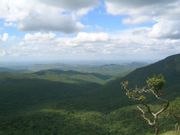
There are three main types of forest in the sanctuary: tropical moist deciduous occur in the western Benne Block, where rainfall is higher than in the other blocks. Tropical dry deciduous forest occurs in the middle and southern tropical dry thorn forests are in the east.
In addition there are patches of tropical semi ever green forest in the Southwest and Western part of Mudumalai. The annual rainfall there exceeds 2,000 mm (79 in). Tree species in this habitat include: Casseria ovoides, Litsea mysorensis, Cinnamomum malabatrum and Olea dioca. Climbers, including: Todalia asiatica, Sneeze Wort (Watakaka volubilis), Gnetum ula and Entada scandens are also found in these semi evergreen forests.
Moist Bamboo brakes are found amidst dry deciduous, moist deciduous and semi-evergreen forests and along the fringes of riparian forests and swamps. There are two species of bamboo found in Mudumalai, the giant clumping bamboos: Bambusa (arundinacea) and Dendrocalamus strictus. Elephants and Gaur eat both species of bamboo.
In all types of forest, a green strip of riparian forest is seen along the shore of dry seasonal and perennial streams. This type of forest remains green in all seasons. The plant species found here includes: Mangifera indica, Pongamia glabra, Terminalia arjuna, Syzygium cumini, Indian rosewood Dalbergia latifolia and the bamboos. Larger mammals such as elephant, gaur, sambar and tiger use riparian forest patches for feeding and resting.
This sanctuary is home to several species of wild relatives of cultivated plants including wild rice, wild ginger, turmeric, Cinnamon, Solanum, Guava, mango and pepper that act as a reserve gene pool for the cultivated plants.[4]
In certain places mixed vegetation types are present. The deciduous trees shed their green leaves during the summer, and adopt a floral garb while the arrival of the monsoons hails fruits and tender greens.[7]
Fauna
There is a high diversity of animal life in the sanctuary with about 50 species of fishes, 21 species of amphibians, 34 species of reptiles, 227 species of birds and 55 species of mammal.
Mammal diversity is higher in the dry deciduous and dry thorn forests than in the other habitats. Thirteen percent of all mammal species in India are present in Mudumalai wildlife sanctuary.
| Mammal species[4] | found in India | in Mudumalai | and their percentage in MWS |
|---|---|---|---|
| Order | # species in India | # species in MWS | % in MWS |
| Primates | 15 | 3 | 20.00 |
| Even-toed ungulates (deer, gaur, pig) | 34 | 7 | 20.50 |
| Proboscidea (elephant) | 1 | 1 | 100 |
| Carnivora (tiger, leopard, sloth bear) | 58 | 19 | 32.70 |
| Pholidota (ant eater) | 1 | 1 | 100 |
| Lagomorpha (black-napped hare) | 11 | 1 | 9.09 |
| Insectivora (shrew) | 3 | 2 | 66.66 |
| Rodentia (rats, squirrel) | 102 | 14 | 13.73 |
| Chiroptera (bats) | 113 | 7 | 6.19 |
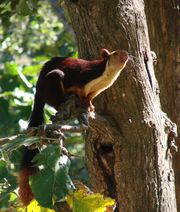
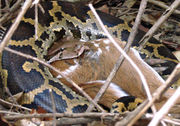
Of 15 cat species in India, 4 live in Mudumalai: Tiger, Panther, Jungle cat and Leopard cat.
Mudumalai Tiger Reserve has the highest density of tigers in the country. For every 8.67 km2, there is now at least one tiger in Mudumalai.[8] There are 44 to 80 Tigers (E) in the Mudumalai forest. The single largest tiger population in India (Mudumalai - Nagarhole - Wynad) includes the Mudumalai tigers. These tigers are a breeding source for populating the Northern and Eastern parts of the Western Ghats. This population exists at high density due to the high density of prey species thriving in its deciduous forests.[9]
The Indian leopard (P. pardus fusca) (NT) is most often seen in the Kargudi area. Other carnivores include the Dhole (Cuon alpinus) (V), the Striped Hyena (Hyaena hyaena) (NT), the Golden Jackal (Canis aureus) and the Sloth Bear (Melursus ursinus) (V).
The population of Indian Elephants, Elephas maximus indicus (E), totals several hundred animals.
Three Primates found here include the Gray langur (Semnopithecus priam) and the Bonnet Macaque (Macaca radiata).
Important prey animals for tigers and panthers here are the Ungulates including the Gaur (Bos gaurus) (V), the Sambar Deer (Cervus unicolor) (VU), the Chital deer (Axis axis), Indian Muntjac (Muntiacus muntjak), the Indian Spotted Chevrotain, Moschiola indica, and the Wild Boar (Sus scrofa), all of whom are common here.
Rodents include the Indian Giant Squirrel (Ratufa indica maxima) and the Red Giant Flying Squirrel (Petaurista petaurista).
Some reptiles found here are the Python, Flying Lizard, Spectacled Cobra, Krait and Asian Pit Vipers.[10] Monitor Lizard is the most regularly observed species.
|
Alpha male Langur |
Warning: Beware of Crocodile at Moyer River! |
Avifauna
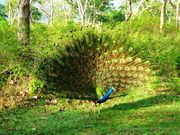
Eight percent of bird species in India occurring in Mudumalai Wildlife Sanctuary. Among the 227 bird species found in Mudumalai, 110 species are insectivores, 62 are carnivores, 23 species are fishivores, 12 species are omnivores and 20 species are grainivores. These include the unique near threatened Black-and-orange Flycatcher. Regional endemics include Malabar trogon and Malabar grey hornbill. Some rare birds of prey like the Rufous bellied hawk eagle can occasionally be seen in this sanctuary. Other predatory birds include crested hawk-eagle, crested serpent eagle, Changeable Hawk Eagle, Black Eagle, Oriental Honey-buzzard, Jerdon's Baza, Bonelli's Eagle, Crested Goshawk, Besra, Mottled Wood Owl and Brown Hawk Owl, Minivet.sp.
There are also Hornbills, Golden Oriole, Chloropsis, Paradise flycatcher, Golden-backed Woodpecker Malabar Great Black Woodpecker, Blue-winged Parakeet, Fairy bluebird, Jungle fowl Racket-tailed Drongo, Peacock, Red Spurfowl, Grey Francolin, Painted Spurfowl, Painted Bush Quail, White-bellied Woodpecker, Lesser Yellownape, Golden Woodpecker, Streak-throated Woodpecker, Chestnut-headed Bee-eater, Emerald Dove, Green Imperial Pigeon, Pompadour Green Pigeon, Grey-bellied Cuckoo, Indian Cuckoo, Alpine Swift, Black-hooded Oriole, Greater Racket-tailed Drongo, Black-headed Cuckooshrike, Grey-headed Bulbul, Forest Wagtail, Crimson-backed Sunbird and Loten's Sunbird. It also holds the isolated southern population of the Striped Tit-babbler.[10][11]
Visitors' information
Park attractions
Attractions in the park include:
- Scenic spots in the sanctuary are the Chief Minister’s Watchtower, the view point at Kargudi, the Ombetta Lake and the Safari Van rides on Sand Road, Circular Road, Manradiar Road, Jayadev Avenue and Bombax Road. The public roads: Kakkanalli – Torapalli road, Teppakkadu – Masanagudi road and Moyar – Masanagudi road are also rewarding places to see wild life in the Sanctuary.
- Moyar River running through the dense forest is a good place to see animals when they come to drink water from the river.
- 'Moyar River Gorge, also called the Moyar Canyon, is a dramatic 20 km (12 mi) long gorge dug out by Moyar River, which plunges into the gorge below Theppakadu in a roaring water-fall popularly known as Moyar falls.[4]
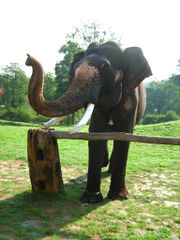
- Elephant Safari and Van Safari, conducted by the Tamil Nadu Forest Department, depart from park headquarters at Theppakadu
- The Elephant Feeding Camp where one can interact with elephants and see how they are fed. The captive elephants in the sanctuary are no longer used for timber extraction work, since these areas are managed exclusively as protected areas. The elephants are engaged mainly for Eco-tourism, patrolling for anti poaching operations, to control Man-Elephant conflict outside the sanctuary or other areas and as a conservation and training center for elephants which can be visited by public.
- Museum near the Elephant feeding camp is where some animals who once lived in the Mudumalai Jungle are preserved.
- Kallatty falls located 30 km (19 mi) from Theppakadu, is a beautiful falls with a breathtaking view.
- Pykara Lake - Located 40 km (25 mi) from Theppakadu is a clean and scenic lake situated between the hills. It is an isolated lake free from pollution and crowds. Boating is conducted here. An annual summer boat race was introduced to this lake in 2008.
Nearby attractions
Bandipur National Park: Bandipur National Park is known for its tiger population. Also, the park shelters some of the most rare and endangered species of wildlife. Bandipur National Park is one of the protected areas within Nilgiri Biosphere Reserve, which is an International Biosphere Reserve in the Western Ghats.
Wayanad Sanctuary: This sanctuary is the second largest wildlife sanctuary in Kerala. It is bestowed with lush green forests and rich wildlife. It houses some of the rare and endangered species of both flora and fauna. The sanctuary comes under Protect Elephant and one can spot herd of elephants roaming in the area.
Masinagudi: There are night safaris in open top jeeps arranged by resorts and guides who are freely accessible in Masinagudi. The night safaris are conducted on the peripheral roads running through the adjoining forest and not into the park. Such night safaris are illegal and create disturbance to the animals of this region. There was a recent incident of a French tourist being killed by a wild elephant when she went on one such safari.
Travel
The nearest airport is at Coimbatore (160 km (99 mi)) and the closest railway station, is at Udhagamandalam (67 km (42 mi)). However, in terms of travel practicality, the convenient railway station is at Mysore (90 km (56 mi)), which is on the major broad gauge line and is served by trains from across the country.
The park is most conveniently accessible by road from Mysore on NH 212 to Gundlupet, then NH 67 to Teppakadu. A little past Bandipur cross the Ari Gouder bridge to a state border check post, passing here one will enter Mudumalai National Park.
Coming from Ooty there are two different routes. One is via Kallatty, 36 km (22 mi) from Ooty on the Masinagudi road that has 36 hairpin bends through natural forests. The other route is by NH 67 via Gudalur which is 67 km (42 mi) from Ooty.
There are regular bus services that connect all the major adjoining cities with this sanctuary.
Accommodations
The forest department has cottages in various locations within the forests available on a first come first serve basis.
There are various private resorts and guest houses that visitors can stay in.
- Greenwoods Nature Camp - an eco friendly wild life nature camp is located at the backdrop of dense Mudumalai/Bandipur wildlife sanctuary. An ideal weekend get away for wildlife or nature enthusiasts, provides affordable packages ( Accommodation, Food, Jeep Safari, Trekking, Camp Fire) with no compromise on the quality.
- Jungle Home Mudumalai Accommodation - offers cottages, swiss cottage tents near stream, family camping tents, good food and activities
Communications
There are three post offices in the sanctuary. STD/ISD/PCO telephone service is available in Theppakadu, Masinagudi, Thorapalli and the nearby towns. The mobile phone network (BSNL) is available in the Sanctuary.[4]
Threats
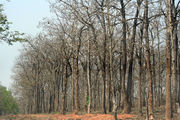
Tourism, especially in the Segur/Masinagudi area, is claimed by some to pose a threat to the region, but this is strongly repudiated by persons who live and work in the area. The resorts do not hinder the movement of wild animals during migration, but misinformed amateur "nature lovers" continue to produce unscientific papers (such as this) that are full of untruths and misinformation. .[12]
The extensive growth of Invasive species, such as lantana, that hinder the natural regeneration process of the forests has occurred as a result of excessive cattle grazing.[7]
Construction activities of the proposed India-based Neutrino Observatory at Singara, Masinagudi, are likely to have significant impacts on the local wildlife. The 5 year work plan, high volume of debris and waste disposal, blasting activities, extensive vehicular activity and large number of outside workers and their support infrastructure all threaten to disrupt the wildlife corridor on the Sigeur plateau, including Mudumalai Sanctuary, connecting the Western ghats and Eastern Ghats.[13][14][15]
See also
- List of birds of South India
References
- Israel, S. and Sinclair, T. (Eds) (1987). Indian Wildlife, Sri Lanka, Nepal. APA Productions, Hong Kong. 363 pp.
- Sestiadti, B. (1986). Mudumalai Sanctuary. India's wildlife and wildlife reserves. Sterling Publishers, New Delhi.
- Sharma, B.D., Shetty, B.V., Virekananthan, K. and Rathakrishnan, N.C. (1978). Flora of Mudumalai Wildlife Sanctuary, Tamil Nadu. Journal of the Bombay Natural History Society 75: 13-42.
- Plan for Mudumalai Wildlife Sanctuary and National Park (2007-08 to 2016-17)[4]
Notes
- ↑ "Mudumalai Wildlife Sanctuary". Conservation database. Bangalore: Ashoka Trust for Research in Ecology and the Environment Eco-Informatics Center. http://www.ecoinfoindia.org/lldb_mudumalai_ws.php. Retrieved 2009-11-09.
- ↑ UNESCO, World Heritage sites, Tentative lists, Western Ghats sub cluster, Ooty. retrieved 4/20/2007 World Heritage sites, Tentative lists
- ↑ "India Based Neutrino Observatory & conserving the largest wild populations of the Asian elephant". Letter to Chief Minister of Tamil Nadu. rainforestinfo.org. http://www.rainforestinfo.org.au/e/ino.htm. Retrieved 2009-11-03.
- ↑ 4.0 4.1 4.2 4.3 4.4 4.5 4.6 Dogra, IFS, Rakesh Kumar, Wildlife Warden, Plan for Mudumalai Wildlife Sanctuary and National Park (2007-08 to 2016-17) Udhagamandalam, Tamil Nadu Forest Department, Mount Stuart Hill, Udhagamandalam-643 001, Tamil Nadu, India
- ↑ PRABHAKAR, R. (2005). "RESOURCE USE, CULTURE AND ECOLOGICAL CHANGE: A CASE STUDY OF THE NlLGlRI HILLS OF SOUTHERN INDIA". Phd Thesis. BANGALORE - 560 012 (INDIA): Centre for Ecological Sciences INDIAN INSTITUTE OF SCIENCE. pp. 82.
- ↑ Murari, S. (31 December 08). "Thousands Protest Against Indian Tiger Reserve". Planet Ark (Reuters). https://www.planetark.org/enviro-news/item/51067. Retrieved 2009-10-30.
- ↑ 7.0 7.1 "Mudumalai Wildlife Sanctuary". Sanctuary Asia. 2009. http://www.sanctuaryasia.com/index.php?option=com_content&view=article&id=310&Itemid=182. Retrieved 2009-11-05.
- ↑ Tiger census in Mudumalai forest
- ↑ "Western Ghats Landscape Complex/Tamil Nadu". STATUS OF TIGERS, CO-PREDATORS AND PREY IN INDIA. National Tiger Conservation Authority Ministry of Environment & Forests and Wildlife Institute of India. 2008. pp. 72–94. http://projecttiger.nic.in/whtsnew/status_of_tigers_in_india_2008.pdf.
- ↑ 10.0 10.1 "MUDUMALAI WILDLIFE SANCTUARY & NATIONAL PARK". Wild Biodiversity. TamilNadu Forest Department. http://www.forests.tn.nic.in/WildBiodiversity/np_mnp.html. Retrieved 2009-10-30.
- ↑ Praveen J., Job K. Joseph & Nick Lethaby (2004) Sighting of Yellow-breasted Babbler Macronous gularis in South India. Newsletter for Ornithologists 1(3):43 PDF
- ↑ Kumar, Gopa. "Why Tiger Tourism Will Never Save The Tiger". The Root Cause Initiative. http://www.rootcause.in/pdf/Article%203.pdf. Retrieved 2009-11-03.
- ↑ The Hindu (2008). "Tiger vs Science". http://www.hinduonnet.com/mag/2008/06/29/stories/2008062950300800.htm. Retrieved 2008-06-29.
- ↑ Azeez, PA; S Bhupathy & P Balasubramanian, (after 30-5-2008). "D. Division of Environmental Impact Assessment". Rapid Environmental Impact Assessmentof the India-Based Neutrino ObservatoryProject, Singara, Nilgiris, Tamil Nadu. Annual Report 2007 - 2008. Sálim Ali Centre for Ornithology and Natural History. Ministry of Environment and Forests. pp. 46, 47. http://envfor.nic.in/divisions/csurv/annual_report_E_2008.pdf.
- ↑ The New Internationalist (2008). "Tiger vs Neutrinos". http://www.newint.org/features/special/2008/08/04/tigers-neutrinos/index.php. Retrieved 2008-08-04.
External links
- UNEP World Conservation Monitoring Centre Fact Sheet, 1988
- Elephants in Mudumalai NP by an expat living in India (Pictures + French text)
- Mudumalai wildlife and landscapes
- Mudumalai Photos 15th Aug 2006 - Courtesy Sasikumar & Ananthi
- Mudumalai Wildlife Bird Photographs
- Mudumalai Accommodation
- NBR Alliance
- Mudumalai Tours and Safaris for trekkers and photographers
|
||||||||||||||||||||||||||||||||||||||||||||||||||||||||||||||||||||||||||||||||||||||||||
|
|||||||||||||||||||||||
|
|||||||||||||||||||||||||||||||||||||||||||||||||||||

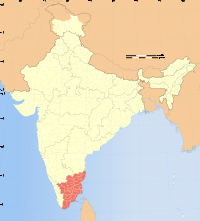
 Gloriosa Lily
Gloriosa Lily